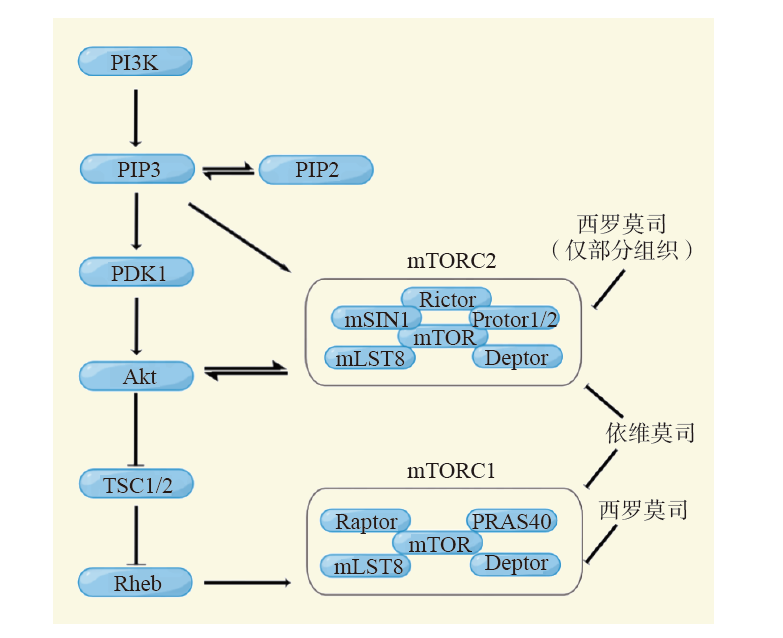| [1] |
FU W, HALL MN. Regulation of mTORC2 signaling[J]. Genes (Basel), 2020, 11(9): 1045. DOI: 10.3390/genes11091045.
|
| [2] |
LIU GY, SABATINI DM. mTOR at the nexus of nutrition, growth, ageing and disease[J]. Nat Rev Mol Cell Biol, 2020, 21(4): 183-203. DOI: 10.1038/s41580-019-0199-y.
|
| [3] |
AKBARZADEH M, MIHANFAR A, AKBARZADEH S, et al. Crosstalk between miRNA and PI3K/Akt/ mTOR signaling pathway in cancer[J]. Life Sci, 2021, 285: 119984. DOI: 10.1016/j.lfs.2021.119984.
|
| [4] |
TEWARI D, PATNI P, BISHAYEE A, et al. Natural products targeting the PI3K-Akt-mTOR signaling pathway in cancer: a novel therapeutic strategy[J]. Semin Cancer Biol, 2022, 80: 1-17. DOI: 10.1016/j.semcancer.2019.12.008.
|
| [5] |
YU L, WEI J, LIU P. Attacking the PI3K/Akt/mTOR signaling pathway for targeted therapeutic treatment in human cancer[J]. Semin Cancer Biol, 2022, 85: 69-94. DOI: 10.1016/j.semcancer.2021.06.019.
|
| [6] |
殷悦涵, 孙丽颖, 田文. 雷帕霉素在神经修复方面作用机制的研究进展[J]. 骨科临床与研究杂志, 2020, 5(6): 372-375, 378. DOI: 10.19548/j.2096-269x.2020.06.013.YIN YH, SUN LY, TIAN W. Advances in the mechanism of rapamycin in neural repair[J]. J Clin Orthop Res, 2020, 5(6): 372-375, 378. DOI: 10.19548/j.2096-269x.2020.06.013.
|
| [7] |
DING Y, CHEN Q. mTOR pathway: a potential therapeutic target for spinal cord injury[J]. Biomed Pharmacother, 2022, 145: 112430. DOI: 10.1016/j.biopha.2021.112430.
|
| [8] |
SCHUBERT-BAST S, STRZELCZYK A. Review of the treatment options for epilepsy in tuberous sclerosis complex: towards precision medicine[J]. Ther Adv Neurol Disord, 2021, 14: 17562864211031100. DOI: 10.1177/17562864211031100.
|
| [9] |
LE SAGE V, CINTI A, AMORIM R, et al. Adapting the stress response: viral subversion of the mTOR signaling pathway[J]. Viruses, 2016, 8(6): 152. DOI: 10.3390/v8060152.
|
| [10] |
江振洲, 范书生, 刘家岐, 等. 中国药物作用靶点研究新进展(Ⅱ)[J]. 药学进展, 2022, 46(10): 771-800. DOI: 10.20053/j.issn1001-5094.2022.10.007.JIANG ZZ, FAN SS, LIU JQ, et al. Progress of research on drug targets in China(Ⅱ)[J]. Prog Pharm Sci, 2022, 46(10): 771-800. DOI: 10.20053/j.issn1001-5094.2022.10.007.j.issn1001-5094.2022.10.007.
|
| [11] |
孙文欢. mTORC1调控抗病毒先天免疫的功能和机制[D]. 江苏: 苏州大学, 2021.
|
| [12] |
VÉZINA C, KUDELSKI A, SEHGAL SN. Rapamycin (AY-22, 989), a new antifungal antibiotic. I. taxonomy of the producing streptomycete and isolation of the active principle[J]. J Antibiot (Tokyo), 1975, 28(10): 721-726. DOI: 10.7164/antibiotics.28.721.
|
| [13] |
POPOVA NV, JÜCKER M. The role of mTOR signaling as a therapeutic target in cancer[J]. Int J Mol Sci, 2021, 22(4): 1743. DOI: 10.3390/ijms22041743.
|
| [14] |
MENEGHINI M, BESTARD O, GRINYO JM. Immunosuppressive drugs modes of action[J]. Best Pract Res Clin Gastroenterol, 2021, 54-55: 101757. DOI: 10.1016/j.bpg.2021.101757.
|
| [15] |
WALDNER M, FANTUS D, SOLARI M, et al. New perspectives on mTOR inhibitors (rapamycin, rapalogs and TORKinibs) in transplantation[J]. Br J Clin Pharmacol, 2016, 82(5): 1158-1170. DOI: 10.1111/bcp.12893.
|
| [16] |
ARRIOLA APELO SI, LAMMING DW. Rapamycin: an inhibitor of aging emerges from the soil of Easter Island[J]. J Gerontol A Biol Sci Med Sci, 2016, 71(7): 841-849. DOI: 10.1093/gerona/glw090.
|
| [17] |
EKBERG H, TEDESCO-SILVA H, DEMIRBAS A, et al. Reduced exposure to calcineurin inhibitors in renal transplantation[J]. N Engl J Med, 2007, 357(25): 2562-2575. DOI: 10.1056/NEJMoa067411.
|
| [18] |
MALLAT SG, TANIOS BY, ITANI HS, et al. CMV and BKPyV infections in renal transplant recipients receiving an mTOR inhibitor-based regimen versus a CNI-based regimen: a systematic review and meta-analysis of randomized, controlled trials[J]. Clin J Am Soc Nephrol, 2017, 12(8): 1321-1336. DOI: 10.2215/CJN.13221216.
|
| [19] |
KNIGHT RJ, GRAVISS EA, NGUYEN DT, et al. Conversion from tacrolimus-mycophenolate mofetil to tacrolimus-mTOR immunosuppression after kidneypancreas transplantation reduces the incidence of both BK and CMV viremia[J]. Clin Transplant, 2018, 32(6): e13265. DOI: 10.1111/ctr.13265.
|
| [20] |
陈淳媛, 孙跃女, 杨作成, 等. 西罗莫司对CVB3感染大鼠心肌成纤维细胞增殖及mTOR表达的影响[J]. 中国新药与临床杂志, 2007, 26(9): 649-652. DOI: 10.3969/j.issn.1007-7669.2007.09.003.CHEN CY, SUN YN, YANG ZC, et al. Effects of sirolimus on cell proliferation and expression of mammalian target of rapamycin in rat myocardial fibroblasts infected by coxsackievirus B3[J]. Chin J New Drugs Clin Rem, 2007, 26(9): 649-652. DOI: 10.3969/j.issn.1007-7669.2007.09.003.j.issn.1007-7669.2007.09.003.
|
| [21] |
张帆, 邢益平. 哺乳动物雷帕霉素靶蛋白抑制剂降低肾移植受者人巨细胞病毒感染的研究进展[J]. 中国感染控制杂志, 2020, 19(7): 666-670. DOI: 10.12138/j.issn.1671-9638.20205846.ZHANG F, XING YP. Advances of mammalian mechanistic target of rapamycin inhibitors in reducing human cytomegalovirus infection in renal transplantation recipients[J]. Chin J Infect Contr, 2020, 19(7): 666-670. DOI: 10.12138/j.issn.1671-9638.20205846.
|
| [22] |
BAK S, TISCHER S, DRAGON A, et al. Selective effects of mTOR inhibitor sirolimus on naïve and CMVspecific T cells extending its applicable range beyond immunosuppression[J]. Front Immunol, 2018, 9: 2953. DOI: 10.3389/fimmu.2018.02953.
|
| [23] |
KAMINSKI H, MARSERES G, YARED N, et al. mTOR inhibitors prevent CMV infection through the restoration of functional αβ and γδ T cells in kidney transplantation[J]. J Am Soc Nephrol, 2022, 33(1): 121-137. DOI: 10.1681/ASN.2020121753.
|
| [24] |
KINDRACHUK J, ORK B, HART BJ, et al. Antiviral potential of ERK/MAPK and PI3K/Akt/mTOR signaling modulation for Middle East respiratory syndrome coronavirus infection as identified by temporal kinome analysis[J]. Antimicrob Agents Chemother, 2015, 59(2): 1088-1099. DOI: 10.1128/AAC.03659-14.
|
| [25] |
BASILE MS, CAVALLI E, MCCUBREY J, et al. The PI3K/Akt/mTOR pathway: a potential pharmacological target in COVID-19[J]. Drug Discov Today, 2022, 27(3): 848-856. DOI: 10.1016/j.drudis.2021.11.002.
|
| [26] |
PINCHERA B, SPIRITO L, BUONOMO AR, et al. mTOR inhibitor use is associated with a favorable outcome of COVID-19 in patients of kidney transplant: results of a retrospective study[J]. Front Med (Lausanne), 2022, 9: 852973. DOI: 10.3389/fmed.2022.852973.
|
| [27] |
REQUIÃO-MOURA LR, MODELLI DE ANDRADE LG, DE SANDES-FREITAS TV, et al. The mycophenolate-based immunosuppressive regimen is associated with increased mortality in kidney transplant patients with COVID-19[J]. Transplantation, 2022, 106(10): e441-e451. DOI: 10.1097/TP.0000000000004251.
|
| [28] |
KLANN K, BOJKOVA D, TASCHER G, et al. Growth factor receptor signaling inhibition prevents SARS-CoV-2 replication[J]. Mol Cell, 2020, 80(1): 164-174. DOI: 10.1016/j.molcel.2020.08.006.
|
| [29] |
MULLEN PJ, GARCIA G JR, PURKAYASTHA A, et al. SARS-CoV-2 infection rewires host cell metabolism and is potentially susceptible to mTORC1 inhibition[J]. Nat Commun, 2021, 12(1): 1876. DOI: 10.1038/s41467-021-22166-4.
|
| [30] |
ABU-EID R, WARD FJ. Targeting the PI3K/Akt/ mTOR pathway: a therapeutic strategy in COVID-19 patients[J]. Immunol Lett, 2021, 240: 1-8. DOI: 10.1016/j.imlet.2021.09.005.
|
| [31] |
ZHENG Y, LI R, LIU S. Immunoregulation with mTOR inhibitors to prevent COVID-19 severity: a novel intervention strategy beyond vaccines and specific antiviral medicines[J]. J Med Virol, 2020, 92(9): 1495-1500. DOI: 10.1002/jmv.26009.
|
| [32] |
KHEZRI MR. PI3K/Akt signaling pathway: a possible target for adjuvant therapy in COVID-19[J]. Hum Cell, 2021, 34(2): 700-701. DOI: 10.1007/s13577-021-00484-5.
|
| [33] |
LOKHANDE AS, DEVARAJAN PV. A review on possible mechanistic insights of nitazoxanide for repurposing in COVID-19[J]. Eur J Pharmacol, 2021, 891: 173748. DOI: 10.1016/j.ejphar.2020.173748.
|
| [34] |
WANG CH, CHUNG FT, LIN SM, et al. Adjuvant treatment with a mammalian target of rapamycin inhibitor, sirolimus, and steroids improves outcomes in patients with severe H1N1 pneumonia and acute respiratory failure[J]. Crit Care Med, 2014, 42(2): 313-321. DOI: 10.1097/CCM.0b013e3182a2727d.
|
| [35] |
SUO L, YU X, HU Y, et al. Sirolimus combined with oseltamivir and corticosteroid treatment for a puerpera with severe pneumonia caused by 2009 pandemic H1N1: a case report[J]. Biosaf Health, 2021, 3(6): 343-350. DOI: 10.1016/j.bsheal.2021.11.003.
|
| [36] |
ZENG Q, WANG J, ZHANG X, et al. Successful combinatorial therapy of sirolimus and neuraminidase inhibitors in a patient with highly pathogenic avian influenza A (H5N6) virus: a case report[J]. Ann Transl Med, 2022, 10(5): 265. DOI: 10.21037/atm-22-704.
|
| [37] |
KUSS-DUERKOP SK, WANG J, MENA I, et al. Influenza virus differentially activates mTORC1 and mTORC2 signaling to maximize late stage replication[J]. PLoS Pathog, 2017, 13(9): e1006635. DOI: 10.1371/journal.ppat.1006635.
|
| [38] |
JIA X, LIU B, BAO L, et al. Delayed oseltamivir plus sirolimus treatment attenuates H1N1 virus-induced severe lung injury correlated with repressed NLRP3 inflammasome activation and inflammatory cell infiltration[J]. PLoS Pathog, 2018, 14(11): e1007428. DOI: 10.1371/journal.ppat.1007428.
|
| [39] |
EHRHARDT C, LUDWIG S. A new player in a deadly game: influenza viruses and the PI3K/Akt signalling pathway[J]. Cell Microbiol, 2009, 11(6): 863-871. DOI: 10.1111/j.1462-5822.2009.01309.x.
|
| [40] |
DHARNIDHARKA VR, CHERIKH WS, ABBOTT KC. An OPTN analysis of national registry data on treatment of BK virus allograft nephropathy in the United States[J]. Transplantation, 2009, 87(7): 1019-1026. DOI: 10.1097/TP.0b013e31819cc383.
|
| [41] |
FAVI E, SIGNORINI L, VILLANI S, et al. In vitro study evaluating the effect of different immunosuppressive agents on human polyomavirus BK replication[J]. Transplant Proc, 2022, 54(7): 2035-2041. DOI: 10.1016/j.transproceed.2022.04.017.
|
| [42] |
HIRSCH HH, YAKHONTOVA K, LU M, et al. BK polyomavirus replication in renal tubular epithelial cells is inhibited by sirolimus, but activated by tacrolimus through a pathway involving FKBP-12[J]. Am J Transplant, 2016, 16(3): 821-832. DOI: 10.1111/ajt.13541.
|
| [43] |
KORTH J, ANASTASIOU OE, VERHEYEN J, et al. Impact of immune suppressive agents on the BK-polyomavirus non coding control region[J]. Antiviral Res, 2018, 159: 68-76. DOI: 10.1016/j.antiviral.2018.09.013.
|
| [44] |
SATO N, SHIRAKI A, MORI KP, et al. Everolimus reduces BK polyomavirus infection by suppressing its replication and spread of infection[J]. Antiviral Res, 2022, 208: 105456. DOI: 10.1016/j.antiviral.2022.105456.
|
| [45] |
ALVAREZ ORELLANA J, KWUN HJ, ARTUSI S, et al. Sirolimus and other mechanistic target of rapamycin inhibitors directly activate latent pathogenic human polyomavirus replication[J]. J Infect Dis, 2021, 224(7): 1160-1169. DOI: 10.1093/infdis/jiaa071.
|
| [46] |
YE C, LI J, LIU X, et al. The incidence of cytomegalovirus and BK polyomavirus infections in kidney transplant patients receiving mTOR inhibitors: a systematic review and meta-analysis[J]. Pharmacotherapy, 2023, 43(6): 552-562. DOI: 10.1002/phar.2799.
|
| [47] |
CHERNEHA M, KORTH J, KAULFUß M, et al. Reactivations of latent viral infections are associated with an increased Thr389 p70S6k phosphorylation in peripheral lymphocytes of renal transplant recipients[J]. Viruses, 2021, 13(3): 424. DOI: 10.3390/v13030424.
|
| [48] |
ASLEH R, VUCICEVIC D, PETTERSON TM, et al. Sirolimus-based immunosuppression is associated with decreased incidence of post-transplant lymphoproliferative disorder after heart transplantation: a double-center study[J]. J Clin Med, 2022, 11(2): 322. DOI: 10.3390/jcm11020322.
|
| [49] |
PETRARA MR, SERRAINO D, DI BELLA C, et al. Immune activation, immune senescence and levels of Epstein Barr virus in kidney transplant patients: impact of mTOR inhibitors[J]. Cancer Lett, 2020, 469: 323-331. DOI: 10.1016/j.canlet.2019.10.045.
|
| [50] |
ZIERHUT H, KANZELMEYER N, BUESCHER A, et al. Course of renal allograft function after diagnosis and treatment of post-transplant lymphoproliferative disorders in pediatric kidney transplant recipients[J]. Pediatr Transplant, 2021, 25(6): e14042. DOI: 10.1111/petr.14042.
|
| [51] |
KIRK AD, CHERIKH WS, RING M, et al. Dissociation of depletional induction and posttransplant lymphoproliferative disease in kidney recipients treated with alemtuzumab[J]. Am J Transplant, 2007, 7(11): 2619-2625. DOI: 10.1111/j.1600-6143.2007.01972.x.
|
| [52] |
SAMPAIO MS, CHO YW, SHAH T, et al. Association of immunosuppressive maintenance regimens with posttransplant lymphoproliferative disorder in kidney transplant recipients[J]. Transplantation, 2012, 93(1): 73-81. DOI: 10.1097/TP.0b013e31823ae7db.
|
| [53] |
MAJEWSKI M, KORECKA M, JOERGENSEN J, et al. Immunosuppressive TOR kinase inhibitor everolimus (RAD) suppresses growth of cells derived from posttransplant lymphoproliferative disorder at allograftprotecting doses[J]. Transplantation, 2003, 75(10): 1710-1717. DOI: 10.1097/01.TP.0000063934.89714.19.
|
| [54] |
NEPOMUCENO RR, BALATONI CE, NATKUNAM Y, et al. Rapamycin inhibits the interleukin 10 signal transduction pathway and the growth of Epstein Barr virus B-cell lymphomas[J]. Cancer Res, 2003, 63(15): 4472-4480.
|
| [55] |
SANG AX, MCPHERSON MC, IVISON GT, et al. Dual blockade of the PI3K/Akt/mTOR pathway inhibits posttransplant Epstein-Barr virus B cell lymphomas and promotes allograft survival[J]. Am J Transplant, 2019, 19(5): 1305-1314. DOI: 10.1111/ajt.15216.
|





 下载:
下载:







